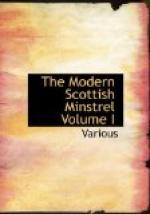“Come gie ’s a
sang, Montgomery cried,
And lay your disputes all
aside;
What signifies ’t for
folks to chide
For
what was done before them?
Let Whig and Tory
all agree,” &c.
Though claiming no distinction as a writer of verses, Mr Skinner did not conceal his ambition to excel in another department of literature. In 1746, in his twenty-fifth year, he published a pamphlet, in defence of the non-juring character of his Church, entitled “A Preservative against Presbytery.” A performance of greater effort, published in 1757, excited some attention, and the unqualified commendation of the learned Bishop Sherlock. In this production, entitled “A Dissertation on Jacob’s Prophecy,” which was intended as a supplement to a treatise on the same subject by Dr Sherlock, the author has established, by a critical examination of the original language, that the words in Jacob’s prophecy (Gen. xlix. 10), rendered “sceptre” and “lawgiver” in the authorised version, ought to be translated “tribeship” and “typifier,” a difference of interpretation which obviates some difficulties respecting the exact fulfilment of this remarkable prediction. In a pamphlet printed in 1767, Mr Skinner again vindicated the claims and authority of his Church; and on this occasion, against the alleged misrepresentations of Mr Norman Sievewright, English clergyman at Brechin, who had published a work unfavourable to the cause of Scottish Episcopacy. His most important work, “An Ecclesiastical History of Scotland, from the first appearance of Christianity in that kingdom,” was published in the year 1788, in two octavo volumes. This publication, which is arranged in the form of letters to a friend, and dedicated, in elegant Latin verse, “Ad Filium et Episcopum,” (to his son, and bishop), by partaking too rigidly of a sectarian character, did not attain any measure of success. Mr Skinner’s other prose works were published after his death, together with a Memoir of the author, under the editorial care




